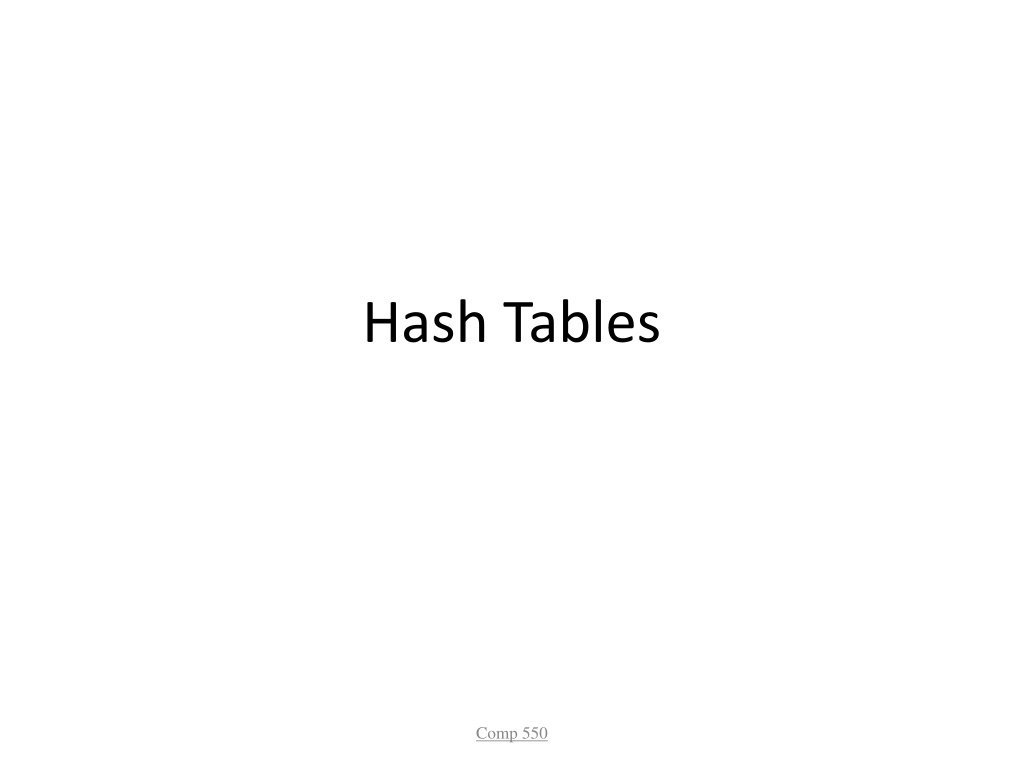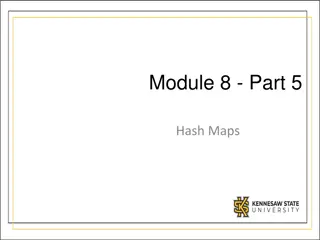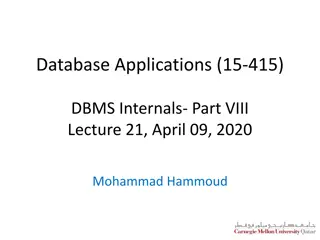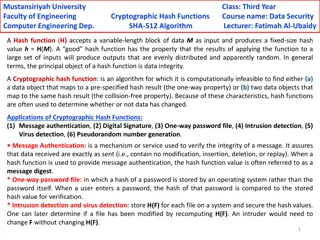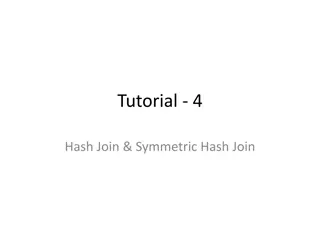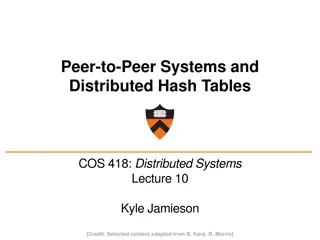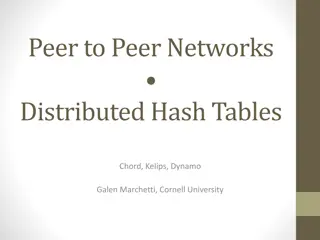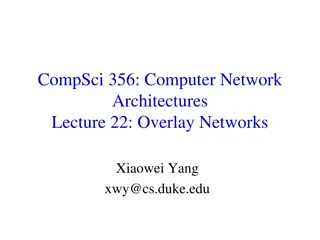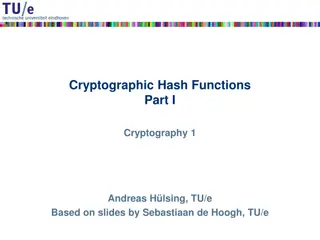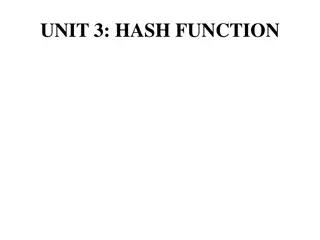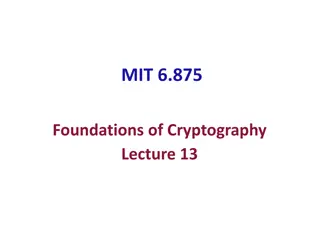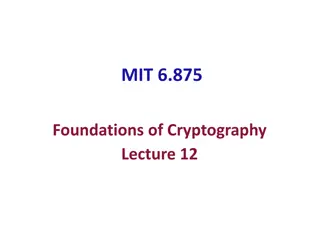Hash Tables
Hash tables are essential data structures that support efficient operations like insertion, search, and deletion. They find applications in symbol tables of compilers, routing tables for network communication, and more. To minimize collisions, choosing the right hash function is crucial. When collisions occur, different methods like separate chaining and open addressing can be employed for resolution. Learn about hash function design, collision resolution strategies, and the complexities involved in hash table operations.
Download Presentation

Please find below an Image/Link to download the presentation.
The content on the website is provided AS IS for your information and personal use only. It may not be sold, licensed, or shared on other websites without obtaining consent from the author.If you encounter any issues during the download, it is possible that the publisher has removed the file from their server.
You are allowed to download the files provided on this website for personal or commercial use, subject to the condition that they are used lawfully. All files are the property of their respective owners.
The content on the website is provided AS IS for your information and personal use only. It may not be sold, licensed, or shared on other websites without obtaining consent from the author.
E N D
Presentation Transcript
Hash Tables Comp 550
Dictionary Dictionary: Dynamic-set data structure for storing items indexed using keys. Supports operations: Insert, Search, and Delete (take O(1) time). Applications: Symbol-table of a compiler. Routing tables for network communication. Associative arrays (python) Page tables, spell checkers, document fingerprints, Hash Tables: Effective implementations of dictionaries. Comp 550
Hashing hash table T[0..m 1]. 0 U (universe of keys) h(k1) h(k4) k1 K k4 (actual keys) k2 h(k2) h(k2) k5 k3 h(k3) h : U {0,1, , m 1} n = |K| << |U|. key k hashes to slot T[h[k]] m 1 Comp 550
Hashing 0 U (universe of keys) h(k1) h(k4) k1 K k4 (actual keys) k2 collision h(k2) h(k2)=h(k5) k5 k3 h(k3) m 1 Comp 550
Two questions: 1. How can we choose the hash function to minimize collisions? 2. What do we do about collisions when they occur? Comp 550
Hash table design considerations Collision resolution separate chaining CLRS 11.2 Hash function design Minimize collisions by spreading keys evenly Collisions must occur because we map many-to-one Collision resolution open address CLRS 11.4 perfect hashing CLRS 11.5 Worst- and average-case times of operations Comp 550
Collision Resolution by Chaining 0 U (universe of keys) h(k1)=h(k4) X k1 k4 K (actual keys) X k2 h(k2)=h(k5)=h(k6) k6 k5 k7 k8 k3 X h(k3)=h(k7) h(k8) m 1 Comp 550
Collision Resolution by Chaining 0 U (universe of keys) k4 k1 k1 k4 K (actual keys) k2 k6 k6 k5 k2 k5 k7 k8 k3 k7 k3 k8 m 1 Comp 550
Hashing with Chaining Dictionary Operations: Chained-Hash-Insert (T, x) Insert x at the head of list T[h(key[x])]. Worst-case complexity: O(1). Chained-Hash-Search (T, k) Search an element with key k in list T[h(k)]. Worst-case complexity: proportional to length of list. Chained-Hash-Delete (T, x) Delete x from the list T[h(key[x])]. Worst-case complexity: search time + O(1). Need pointer to preceding element, or a doubly-linked list. Comp 550
Analysis of Chained-Hash-Search Worst-case search time: time to compute h(k) + (n). Average time: depends on how h distributes keys among slots. Assume Simple uniform hashing. Any key is equally likely to hash into any of the slots, independent of where any other key hashes to. O(1) time to compute h(k). Define Load factor =n/m = average # of keys per slot. n number of keys stored in the hash table. m number of slots = # linked lists. Comp 550
Some results Theorem: An unsuccessful search takes expected time (1+ ). Theorem: A successful search takes expected time (1+ ). Theorem: For the special case with m=n slots, with probability at least 1-1/n, the longest list is O(ln n / ln ln n). Comp 550
Implications for separate chaining If n = O(m), then load factor =n/m = O(m)/m = O(1). Search takes constant time on average. Deletion takes O(1) worst-case time if you have a pointer to the preceding element in the list. Hence, for hash tables with chaining, all dictionary operations take O(1) time on average, given the assumptions of simple uniform hashing and O(1) time hash function evaluation. Extra memory (& coding) needed for linked list pointers. Can we satisfy the simple uniform hashing assumption? Comp 550
Good hash functions CLRS 11.2 Comp 550
Good Hash Functions Recall the assumption of simple uniform hashing: Any key is equally likely to hash into any of the slots, independent of where any other key hashes to. O(1) time to compute h(k). Hash values should be independent of any patterns that might exist in the data. E.g. If each key is drawn independently from U according to a probability distribution P, we want for all j [0 m 1], k:h(k) = j P(k) = 1/m Often use heuristics, based on the domain of the keys, to create a hash function that performs well. Comp 550
Division Method (mod p) Map each key k into one of the m slots by taking the remainder of k divided by m. That is, h(k) = k mod m Example: m = 31 and k = 78 h(k) = 16. Advantage: Fast, since requires just one division operation. Disadvantage: For some values, such as m=2p, the hash depends on just a subset of the bits of the key. Good choice for m: Primes are good, if not too close to power of 2 (or 10). Comp 550
Multiplication Method Map each key k to one of the m slots indicated by the fractional part of k times a chosen real 0 < A < 1. That is, h(k) = m (kA mod1) = m (kA kA ) Example: m = 1000, k = 123, A 0.6180339887 h(k) = 1000(123 0.6180339887 mod1) = 1000 0.018169... = 18. Disadvantage: A bit slower than the division method. Advantage: Value of m is not critical. Details on next slide Comp 550
Multiplication Mthd. Implementation Simple implementation for m a power of 2. Choose m = 2p, for some integer p. Let the word size of the machine be w bits. Pick a w-bit 0 < s < 2w. Knuth suggests ( 5 1) 2w-1. Let A = s/2w. (We need 0<A<1.) Assume that key k fits into a single word. (k takes w bits.) Compute k s = r1 2w+ r0 The integer part of kA = r1 , drop it. Take the first p bits of r0 by r0 << p w bits k s = A 2w binary point r1 r0 extract p bits h(k) Comp 550
Open Addressing Idea: Store all n keys in the m slots of the hash table itself. What can you say about the load factor = n/m? Each slot contains either a key or NIL. To searchfor key k: Examine slot h(k). Examining a slot is known as a probe. If slot h(k) contains key k, the search is successful. If the slot contains NIL, the search is unsuccessful. There s a third possibility: slot h(k) contains a key that is not k. Compute the index of some other slot, based on k and which probe we are on. Keep probing until we either find key k or we find a slot holding NIL. Advantages: Avoids pointers; so less code, and we can dedicate the memory to the table. Comp 550
Open addressing 0 U (universe of keys) h(k1) h(k4) k1 K k4 (actual keys) k2 collision h(k2) h(k2)=h(k5) h(k5)+1 k5 k3 h(k3) m 1 Comp 550
Probe Sequence Sequence of slots examined during a key search constitutes a probe sequence. Probe sequence must be a permutation of the slot numbers. We examine every slot in the table, if we have to. We don t examine any slot more than once. One way to think of it: extend hash function to: h : U {0, 1, , m 1} {0, 1, , m 1} probe number slot number Universe of Keys Comp 550
Operations: Search & Insert Hash-Insert(T, k) 1. i 0 2. repeatj h(k, i) 3. ifT[j] = NIL 4. thenT[j] k 5. return j 6. else i i + 1 7. until i = m 8. error hash table overflow Hash-Search (T, k) 1. i 0 2. repeat j h(k, i) 3. ifT[j] = k 4. thenreturn j 5. i i + 1 6. untilT[j] = NIL or i = m 7. return NIL Search looks for key k Insert first searches for a slot, then inserts (line 4). Comp 550
Deletion Cannot just turn the slot containing the key we want to delete to contain NIL. Why? Use a special value DELETED instead of NIL when marking a slot as empty during deletion. Search should treat DELETED as though the slot holds a key that does not match the one being searched for. Insert should treat DELETED as though the slot were empty, so that it can be reused. Disadvantage: Search time is no longer dependent on . Hence, chaining is more common when keys have to be deleted. Comp 550
Computing Probe Sequences The ideal situation is uniform hashing: Generalization of simple uniform hashing. Each key is equally likely to have any of the m! permutations of 0, 1, , m 1 as its probe sequence. It is hard to implement true uniform hashing. Approximate with techniques that guarantee to probe a permutation of [0 m 1], even if they don t produce all m! probe sequences Linear Probing. Quadratic Probing. Double Hashing. Comp 550
Linear Probing h(k, i) = (h(k,0)+i) mod m. key Probe number Original hash function The initial probe determines the entire probe sequence. Suffers from primary clustering: Long runs of occupied sequences build up. Long runs tend to get longer, since an empty slot preceded by i full slots gets filled next with probability (i+1)/m. Quadratic Probing h(k,i) = (h (k) + c1i + c2i2)mod m c1 c2 Can suffer from secondary clustering Comp 550
Open addressing with linear probing 0 U (universe of keys) h(k1) h(k4) k1 K k4 (actual keys) k2 collision h(k2) h(k2)=h(k5) h(k5)+1 k5 k3 h(k3) m 1 Comp 550
Double Hashing h(k,i) = (h1(k) + i h2(k))mod m key Probe number Auxiliary hash functions Two auxiliary hash functions. h1 gives the initial probe. h2 gives the remaining probes. Must have h2(k) relatively prime to m, so that the probe sequence is a full permutation of 0, 1, , m 1 . Choose m to be a power of 2 and have h2(k) always return an odd number. Or, Let m be prime, and have 1 < h2(k) < m. (m2) different probe sequences. One for each possible combination of h1(k) and h2(k). Close to the ideal uniform hashing. Comp 550
Open addressing with double hashing 0 U (universe of keys) h1(k1) =h1(k5)+ h2(k5) h1(k4) k1 K k4 (actual keys) k2 collision h1(k2) h1(k2)=h1 (k5) k5 k3 h1(k3) h1(k5)+ 2h2(k5) Comp 550
Analysis of Open-address Hashing Analysis is in terms of load factor = n/m. Assumptions: The table never completely fills, so n <m and < 1. uniform hashing (all probe sequences equally likely) no deletion In a successful search, each key is equally likely to be searched for. Comp 550
Expected cost of an successful search Theorem: Under the uniform hashing assumption, the expected number of probes in an unsuccessful search in an open-address hash table is at most 1/(1 ). Proof: Let Pk= IRV{the first k 1 probes hit occupied slots} The expected number of probes is just = 1 1 m k m k 1 1 k 0 m = 1 k k ( ) ( ) E P E P k k 1 k If is a constant, search takes O(1) time. Corollary: Inserting an element into an open-address table takes 1/(1 ) probes on average. Comp 550
Expected cost of a successful search Theorem: Under the uniform hashing assumption, the expected number of probes in a successful search in an open-address hash table is at most (1/ ) ln (1/(1 )). Proof: A successful search for a key k follows the same probe sequence as when k was inserted. Suppose that k was the (i+1)st key inserted. At that time, was i/m. By the previous corollary, the expected number of probes inserting k was at most 1/(1 i/m) = m/(m i). We need to average over i=1..n, the positions for key k. m i m n i i key for expected are probes 1 1 n n 1 1 1 1 1 m = = Thus, ( ) ln H H m m n 1 n m i = = 0 0 k Comp 550
Universal Hashing A malicious adversary who has learned the hash function can choose keys that map to the same slot, giving worst- case behavior. Defeat the adversary using Universal Hashing Use a different random hash function each time. Ensure that the random hash function is independent of the keys that are actually going to be stored. Ensure that the random hash function is good by carefully designing a class of functions to choose from. Comp 550
Universal Set of Hash Functions A finite collection of hash functions H, that map a universe of keys U into {0, 1, , m 1}, is universal if, for every pair of distinct keys k,l U, the number of h H with h(k)=h(l) is |H|/m. Key idea: use number theory to pick a large set H where choosing h H at random makes Pr{h(k)=h(l) } = 1/m. (A random h can be expected to satisfy simple uniform hashing.) With table size m, pick a prime p the largest key. Define a set of hash functions for a,b [0 p 1], a>0, ha,b(k) = ( (ak + b) mod p) mod m. Related to linear conguential random number generators (CLRS 31) Comp 550
Example Set of Universal Hash Fcns With table size m, pick a prime p the largest key. Define a set of hash functions for a,b [0 p 1], a>0, ha,b(k) = ( (ak + b) mod p) mod m. Claim: H is a 2-universal family. Proof: Let's fix r s and calculate, for keys x y, Pr([(ax + b) = r (mod p)] AND [(ay+b) = s (mod p)]). We must have a(x y) = (r s) mod p, which is uniquely determines a over the field Zp+, so b = r ax (mod p). Thus, this probability is 1/p(p 1). Now, the number of pairs r swith r = s (mod m) is p(p 1)/m, so Pr[(ax+b mod p) = (ay+b mod p) (mod n)] = 1/m. QED Comp 550
Chain-Hash-Search with Universal Hashing Theorem: Using chaining and universal hashing on key k: If k is not in the table T, the expected length of the list that k hashes to is . If k is in the table T, the expected length of the list that k hashes to is 1+ . Proof: Xkl = IRV{h(k)=h(l)}. E[Xkl] = Pr{h(k)=h(l)} 1/m. If key , expected # of pointer refs. is If key k T, expected # of pointer refs. is ( 1 + j i k T 1 ( ) 1 n n i = i = ( ) E X ij m m j j ) 1 m 1 m ( n n i = + = + + ) 1 1 1 E X ij 2 2 j Comp 550
Perfect Hashing [FKS82] k1 U (universe of keys) k4 k1 k4 k5 K (actual keys) k2 k6 k5 k7 k2 k3 k7 k6 k3 Comp 550
) 1 ( n n 2 = ( ) E X Two consequences of ij m i j Recall our analyses for search with chaining: we let Xij=IRV{keys i & j hash to same slot} Consider m = n2: If the average # of collisions < , then more than half the time we have no collisions! Pick a random universal hash function and hash into table with m=n2. Repeat until no collision. ( ) 1 2 1 n n i = ( ) E X ij 2 2 n j Note: Thm. 11.9 in CLRS; uses Markov inequality in proof. Comp 550
) 1 ( n n 2 = Two consequences of ( ) E X ij m i j Consider m=n: We can show that (list sizes)2 add up to O(n) Let Zi,k=IRV{key i hashes to slot k} Let Xij=IRV{keys i & j hash to same slot} ) ( ) ( 1 1 1 n i m k n i i + 2 ) = 2 ( ) ( E Z E X E n X , i k ii ij 1 j ) 1 m ( n n = + = 2 1 n n Note: Thm. 11.10 in CLRS. Comp 550
) 1 ( n n 2 = Two consequences of ( ) E X ij m i j Let Zi,k=IRV{key i hashes to slot k} Let Xij=IRV{keys i & j hash to same slot} ) ( 1 1 = ( ) = 2 ( ) ( )( ) E Z E Z Z n ) ) , , , i k i k j k 1 1 1 k m i n k m i n j ( ( E Z Z , , i k j k 1 , 1 i j n k ) m = = + ( ( 2 ) E X n E X X n ij ii ij 1 , 1 1 i j i n i j = + 2 ) ( ) ( E X E n X ii ij 1 1 i n i j ) 1 ( n n = + n m Comp 550
Perfect Hashing If you know the n keys in advance, makes a hash table with O(n) size, and worst-case O(1) lookup time. Just use two levels of hashing: A table of size n, then tables of size nj2. k1 k4 k5 k2 k6 k7 k3 Dynamic versions have been created, but are usually less practical than other hash methods. Key idea: exploit both ends of space/#collisions tradeoff. Comp 550
